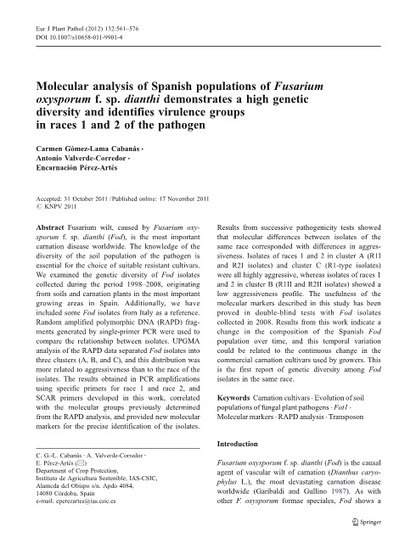Via Scoop.it – PCR PRIMERS FOR THE IDENTIFICATION OF PHYTOPATHOGENIC FUNGI
 Fusarium wilt, caused by Fusarium oxysporum f. sp. dianthi (Fod), is the most important carnation disease worldwide. The knowledge of the diversity of the soil population of the pathogen is essential for the choice of suitable resistant cultivars. We examined the genetic diversity of Fod isolates collected during the period 1998–2008, originating from soils and carnation plants in the most important growing areas in Spain. Additionally, we have included some Fod isolates from Italy as a reference. Random amplified polymorphic DNA (RAPD) fragments generated by single-primer PCR were used to compare the relationship between isolates. UPGMA analysis of the RAPD data separated Fod isolates into three clusters (A, B, and C), and this distribution was more related to aggressiveness than to the race of the isolates. The results obtained in PCR amplifications using specific primers for race 1 and race 2, and SCAR primers developed in this work, correlated with the molecular groups previously determined from the RAPD analysis, and provided new molecular markers for the precise identification of the isolates. Results from successive pathogenicity tests showed that molecular differences between isolates of the same race corresponded with differences in aggressiveness. Isolates of races 1 and 2 in cluster A (R1I and R2I isolates) and cluster C (R1-type isolates) were all highly aggressive, whereas isolates of races 1 and 2 in cluster B (R1II and R2II isolates) showed a low aggressiveness profile. The usefulness of the molecular markers described in this study has been proved in double-blind tests with Fod isolates collected in 2008. Results from this work indicate a change in the composition of the Spanish Fod population over time, and this temporal variation could be related to the continuous change in the commercial carnation cultivars used by growers. This is the first report of genetic diversity among Fod isolates in the same race.
Fusarium wilt, caused by Fusarium oxysporum f. sp. dianthi (Fod), is the most important carnation disease worldwide. The knowledge of the diversity of the soil population of the pathogen is essential for the choice of suitable resistant cultivars. We examined the genetic diversity of Fod isolates collected during the period 1998–2008, originating from soils and carnation plants in the most important growing areas in Spain. Additionally, we have included some Fod isolates from Italy as a reference. Random amplified polymorphic DNA (RAPD) fragments generated by single-primer PCR were used to compare the relationship between isolates. UPGMA analysis of the RAPD data separated Fod isolates into three clusters (A, B, and C), and this distribution was more related to aggressiveness than to the race of the isolates. The results obtained in PCR amplifications using specific primers for race 1 and race 2, and SCAR primers developed in this work, correlated with the molecular groups previously determined from the RAPD analysis, and provided new molecular markers for the precise identification of the isolates. Results from successive pathogenicity tests showed that molecular differences between isolates of the same race corresponded with differences in aggressiveness. Isolates of races 1 and 2 in cluster A (R1I and R2I isolates) and cluster C (R1-type isolates) were all highly aggressive, whereas isolates of races 1 and 2 in cluster B (R1II and R2II isolates) showed a low aggressiveness profile. The usefulness of the molecular markers described in this study has been proved in double-blind tests with Fod isolates collected in 2008. Results from this work indicate a change in the composition of the Spanish Fod population over time, and this temporal variation could be related to the continuous change in the commercial carnation cultivars used by growers. This is the first report of genetic diversity among Fod isolates in the same race.
Carmen Gómez-Lama Cabanás, Antonio Valverde-Corredor and Encarnación Pérez-Artés
EUROPEAN JOURNAL OF PLANT PATHOLOGY
Volume 132, Number 4, 561-576
http://dx.doi.org/10.1007/s10658-011-9901-4
Via www.springerlink.com
According to these findings, DATABASE RECORD #49 has been updated and RECORDS #532 and 533 have been created.

